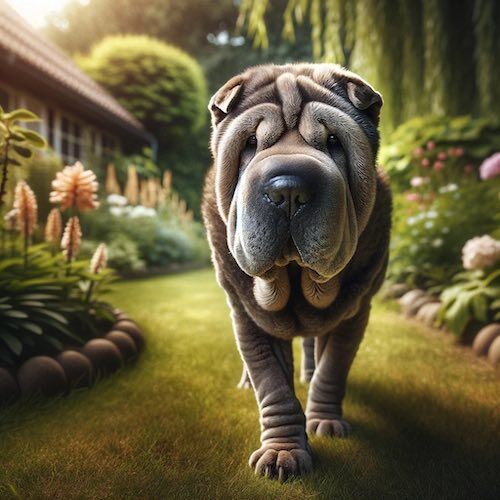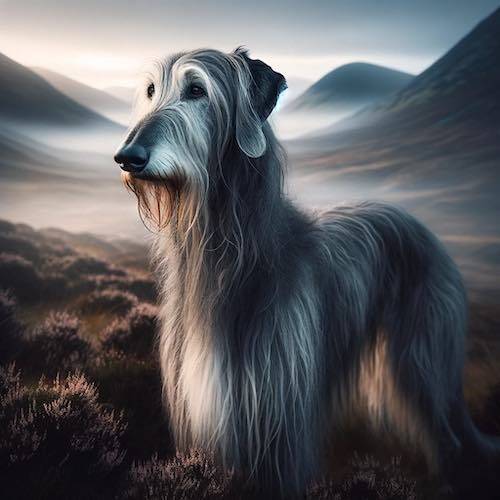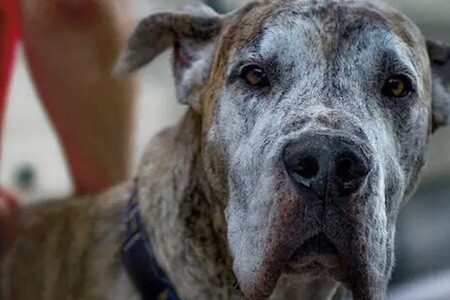Dogs have stood by humanity’s side for millennia, not just as pets but as loyal companions, guides, and friends. With a diversity that spans from the petite lap dogs to the towering Great Danes, each breed brings its own distinctive personality and set of characteristics to the table. However, a shared reality across all dog breeds is their comparatively shorter lifespan when contrasted with humans.
In the United States, the average human lifespan hovers around 79 years, yet many dog breeds only live to see 10-12 years. This stark difference means that pet owners often have just a decade or so to spend with their cherished four-legged friends before facing the inevitable farewell.
The departure of a pet is always a poignant moment, yet it’s even more pronounced for owners of certain breeds that, due to genetic factors or health predispositions, tend to have even shorter lifetimes than the average canine.
Awareness of these breeds can empower future pet owners to fully prepare for the commitment and cherish the time they have with these animals. Here are Top 10 Dog Breeds With The Shortest Lifespans, offering a guide for those looking to open their homes and hearts to these special companions.
Shar Pei: 8-10 years

The Shar Pei is an ancient breed of dog that has been around for centuries. This unique-looking canine is distinguished by its wrinkled, blue-black colored coat and distinctive muzzle. While the Shar Pei can make a wonderful family pet, they do have some health issues that should be taken into consideration before bringing one home.
Due to their short snouts and other physical characteristics, Shar Peis suffer from several common ailments including entropion (eyelids turning inward), skin allergies, dermoid sinus (a rare neurological condition) and hip dysplasia.
This breed is known for its unique and distinctive wrinkled skin, which can be prone to a range of dermatological conditions. One of the primary concerns is Shar Pei Fever, also known as Familial Shar-Pei Fever (FSF), which is an inherited condition causing recurrent episodes of fever and inflammation.
Another common skin problem in Shar Pei’s is called cutaneous mucinosis, which involves the excessive production and accumulation of a substance called mucin in the skin, leading to thickened, spongy, and wrinkled skin.
Additionally, they may be prone to allergies, pyoderma (skin infections), and skin fold dermatitis due to the folds and wrinkles in their skin. Regular skin care, including proper cleaning and drying of skin folds, can help prevent infections and maintain the skin’s health. It is essential for Shar Pei owners to closely monitor their dog’s skin, seek veterinary care at the first signs of any issues, and follow a veterinarian’s recommendations for managing and treating skin problems in this breed.
Scottish Deerhound: 8-10 years

The Scottish Deerhound, also known as the Royal Dog of Scotland, is a large breed of dog that was originally bred to hunt deer. It is a strong and powerful breed with an impressive lifespan for its size. The average life expectancy of the Scottish Deerhound is between 8 and 10 years when properly cared for.
This majestic hound has been used throughout history to track game in harsh terrain due to its immense strength, agility, speed, and endurance. Despite its intimidating size, this gentle giant makes an excellent companion due to their loving nature and easy-going attitude toward people and other animals alike. With proper care and nutrition they can live long healthy lives full of joyous playtime adventures!
Broholmer: 8-10 years
The Broholmer is a large, powerful dog breed that originated in Denmark. This loyal and friendly breed has been around since the 18th century, and it is well-known for its strength and agility.
The Broholmer stands at an average of 24-28 inches tall and weighs between 80 to 110 pounds. It comes in two color varieties: black with tan markings or yellow with black markings. Its thick coat requires regular brushing to keep it looking healthy and shiny.
The health of the Broholmer is generally good, although there are some conditions they can be prone to such as hip dysplasia, entropion (eyelid inversion) allergies or skin issues caused by their thick coats. They should have regular checkups with their vet so any underlying medical conditions can be identified early on before they become more serious problems down the line.
Additionally, Broholmers may be susceptible to certain cardiac disorders, such as dilated cardiomyopathy. Eye problems, including entropion and ectropion, where the eyelids roll inwards or outwards, respectively, may also be observed.
Responsible breeding practices, including health screenings, can help reduce the risk of these health conditions. Regular exercise, a balanced diet, routine veterinary check-ups, and maintaining a healthy weight are essential in promoting the overall health and well-being of a Broholmer dog.
Generally speaking though, this breed has a lifespan of 8-10 years when properly cared for which means providing them with adequate exercise, nutritious food, grooming care and plenty of love!
Cane Corso: 8-10 years
The Cane Corso, also known as the Italian Mastiff, is a large and powerful breed of dog that originated in Italy. This strong and active breed has been used for centuries to guard property and livestock, but today they make devoted family companions. They are intelligent dogs with a loyal streak that makes them excellent protectors.
The Cane Corso is generally healthy, but like any other large breed they can suffer from certain health issues if not properly cared for or bred responsibly. Lifespan for a Cane Corso averages 8-10 years. It’s important to understand the potential health problems associated with this breed so you can provide your pet with proper care throughout their lifetime.
Cane Corsos are generally quite healthy dogs, but like many larger breeds they may be prone to hip dysplasia and elbow dysplasia which can lead to arthritis later in life. Other common conditions include eye problems such as entropion (inward rolling eyelids) and ectropion (outward rolling eyelids). Bloat is another condition seen more commonly in larger breeds due to their deep chests; however it is treatable if caught early enough.
Additionally, they may be prone to certain cardiac issues, including dilated cardiomyopathy. Certain cancers, such as osteosarcoma (bone cancer), can also occur in Cane Corsos.
Saint Bernard: 7-10 years
Saint Bernard dogs are one of the largest breeds of domesticated canines, and they have a lifespan to match their impressive size. On average, these gentle giants live for 7-10 years, although with proper care and nutrition it is possible for them to reach up to 12 years old.
The major health issues associated with Saint Bernards are primarily related to their large size and genetic predispositions. One of the primary concerns is hip dysplasia, a genetic condition affecting the hip joints, which can lead to pain, lameness, and arthritis. Elbow dysplasia is also relatively common in this breed.
Another significant health issue for Saint Bernards is a condition called gastric dilatation-volvulus (GDV), commonly known as bloat. This is a life-threatening emergency where the stomach becomes distended and can twist on itself, requiring immediate veterinary intervention.
Saint Bernards may also be prone to certain cardiac conditions, such as dilated cardiomyopathy. Other potential health concerns in this breed include osteosarcoma (bone cancer), entropion (inward rolling of the eyelids), and skin infections in the folds of their skin.
Responsible breeding practices, regular veterinary check-ups, a balanced diet, exercise, and weight management are crucial for maintaining the overall health and well-being of a Saint Bernard. Early detection and prompt treatment of any potential health issues are essential for ensuring a longer and healthier life for these gentle giants.
Newfoundland: 7-10 years
The Newfoundland dog is a large, strong breed of working dogs that originated from the island of Newfoundland, off the coast of Canada. They are known for their loyal and gentle nature as well as their impressive strength.
Newfoundlands are powerful swimmers and have been used to pull boats, rescue people in distress on water bodies and even haul wood. Though they make great companions and family pets, it is important to understand their health needs in order to take proper care of them.
The average lifespan of a Newfoundland dog ranges between 7-10 years but may be shorter depending upon any underlying health issues or hereditary conditions that can affect this breed’s life expectancy.
Health problems such as hip dysplasia, entropion (eyelid disorder), subvalvular aortic stenosis (heart condition) and cystinuria (urine condition) are some common ailments found in these dogs which can significantly reduce their lifespan if not treated properly.
Regular veterinary check-ups with preventive medications like vaccinations against infectious diseases should also be given to help maintain good health throughout the lifetime of your pet.
Great Dane: 7-10 years
Great Danes are a magnificent and imposing breed known for their large size and gentle temperament. When it comes to their health, there are several considerations to keep in mind.
Great Danes, like many large and giant breeds, are prone to certain health issues, including musculoskeletal problems. They have a higher risk of developing joint conditions such as hip dysplasia and elbow dysplasia, which can lead to pain, lameness, and arthritis. Additionally, they can be susceptible to conditions like osteochondritis dissecans (OCD), a disorder affecting the development of joint cartilage, particularly in the shoulder joint.
One significant health concern for Great Danes is a higher predisposition to certain types of cancer. They have an increased risk of developing various cancers, including osteosarcoma (bone cancer), lymphoma, and gastric dilatation-volvulus (GDV) that can lead to stomach torsion. These conditions can significantly impact the lifespan of Great Danes.
Regarding lifespan, Great Danes typically have a shorter lifespan compared to smaller breeds. On average, their lifespan ranges from 7 to 10 years. The size of the breed is a contributing factor, as larger dogs often have shorter lifespans. However, there are also individual variations, and with proper care and management, some Great Danes can live into their early teens.
To promote the health and well-being of Great Danes, responsible breeding practices are essential. Health screenings, including hip and elbow evaluations, can help identify potential issues before breeding. Regular veterinary check-ups, a balanced diet suitable for large breeds, exercise appropriate for their age and condition, and weight management are crucial for maintaining their overall health.
Early detection and prompt treatment of any health concerns, including regular cancer screenings, can help improve outcomes and potentially extend their lifespan. Providing a safe and comfortable environment, socialization, and mental stimulation are equally important for their overall well-being.
While Great Danes may have a shorter lifespan, their immense presence and gentle nature make them cherished family members. With proper care and attention, they can lead happy and fulfilling lives.
Irish Wolfhound: 6-9 years
The Irish Wolfhound is a majestic and ancient breed known for its large size and gentle nature. When it comes to their health and lifespan, Irish Wolfhounds generally have a shorter lifespan compared to some other dog breeds. On average, the lifespan of an Irish Wolfhound ranges from 6 to 8 years.
One of the primary factors contributing to their shorter lifespan is their large size. Like other giant breeds, Irish Wolfhounds tend to have shorter lifespans compared to smaller breeds. This is believed to be related to various factors, including a higher risk of orthopedic issues, such as hip and elbow dysplasia, as well as a higher metabolic rate, which can put more strain on their bodies.
Despite their impressive size, Irish Wolfhounds are generally a healthy breed with few specific health issues. However, they are still prone to certain genetic and large breed-related health conditions. These can include bloat (gastric dilatation-volvulus), certain types of cancer, heart conditions like dilated cardiomyopathy, and musculoskeletal issues.
Responsible breeding practices, including health screenings and genetic testing, can help reduce the prevalence of inherited health issues in Irish Wolfhounds. Regular veterinary check-ups, a balanced diet, appropriate exercise, and weight management are also crucial in maintaining their overall health and well-being.
While the lifespan of Irish Wolfhounds may be shorter, it is important to focus on quality rather than quantity. Providing them with a loving, nurturing environment, proper healthcare, and a fulfilling lifestyle can help maximize their time and ensure they have a happy and comfortable life. Early detection and management of any potential health issues are essential for promoting their longevity and overall well-being.
Dogue de Bordeaux: 6-8 years
The Dogue de Bordeaux is a large, powerful breed of dog that has been around for centuries. They are loyal and devoted to their owners, making them great family pets. The Dogue de Bordeaux is known for its short muzzle and broad head, as well as its muscular body. This breed is also very intelligent and can be trained easily.
When it comes to health issues and lifespan, the Dogue de Bordeaux does have some potential health concerns that should be monitored throughout their life span. These include hip dysplasia, elbow dysplasia, patellar luxation and entropion (eyelid disorder).
Although these conditions can be managed with proper care from a veterinarian, they may shorten the lifespan of this breed if left untreated or ignored. Additionally, due to its size and weight this breed is prone to obesity which can lead to further complications such as arthritis or joint problems later in life.
Therefore it’s important that this breed gets regular exercise so they stay at a healthy weight throughout their lives.
Genetics also play a role in determining the lifespan of a Dogue de Bordeaux. Responsible breeders who prioritize health screenings and selective breeding can help reduce the prevalence of inherited health issues, thus potentially improving the overall health and lifespan of the breed.
It’s important for Dogue de Bordeaux owners to be proactive in their dog’s healthcare, including regular veterinary check-ups, a balanced diet, exercise, and weight management. Early detection and proper management of any potential health issues can help maximize the lifespan and quality of life for this beloved breed.
Bernese Mountain Dog: 6-8 years
READ: TOP 10 DOG BREEDS WITH THE LONGEST LIFESPANS
The Bernese Mountain Dog is known to have a relatively small gene pool, which refers to a limited genetic diversity within the breed’s population. This small gene pool is primarily a result of the breed’s historical background and the challenges associated with breed preservation.
The Bernese Mountain Dog originated in Switzerland, where it was primarily used as a working dog in the Swiss Alps. The breed’s population was initially small, and it faced near extinction in the late 19th century. Efforts were made to revive and preserve the breed, but the limited number of foundation dogs available at that time resulted in a reduced genetic diversity.
Maintaining a large gene pool is important for the overall health and vitality of a breed. A diverse gene pool helps to reduce the risk of inherited health issues and improves the breed’s ability to adapt to changing environments and challenges. In contrast, a small gene pool can increase the likelihood of inherited diseases, reduce overall fitness, and limit the breed’s resilience to environmental changes.
The small gene pool in Bernese Mountain Dogs has contributed to the breed’s susceptibility to certain health conditions, including various forms of cancer, orthopedic issues like hip and elbow dysplasia, and other genetic disorders. With limited genetic diversity, the breed is more susceptible to passing on these conditions to future generations.
Efforts are being made by responsible breeders and breed clubs to address these challenges and minimize the negative impacts of the small gene pool. Careful selection of breeding pairs, health screenings, and genetic testing are employed to reduce the prevalence of inherited health issues. Collaboration between breeders and sharing of genetic resources with other populations can also help introduce new genetic diversity into the breed.
It is important for Bernese Mountain Dog owners and breeders to be aware of the potential health risks associated with the small gene pool and work towards responsible breeding practices that prioritize genetic diversity and overall health. By doing so, they can help preserve the breed’s well-being and longevity in the face of these genetic challenges.








